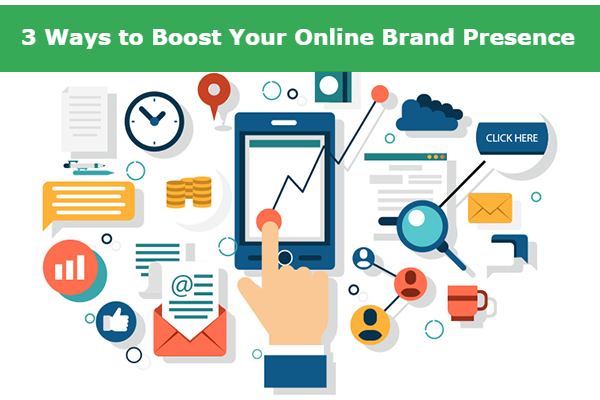3 Ways to Boost Your Online Brand Presence
The majority of 21st-century consumers now look for the businesses they will grow to trust in the long run through the Internet. This is the very reason why business owners who wish to make their companies a household name must raise awareness by making their brand known online.
While there are no shortcuts to success, you can bring your company one step closer by boosting your online presence. Aside from helping to build a better brand reputation, a solid online presence can also help you and your company become a figure of authority in the industry. For experienced professional brand consultants, achieving this not only helps improve sales, but also translates to success for any business.
Wondering what you can do to expand your brand’s clout online? Here are three methods that can effectively boost your online presence:
1. Website Optimization:
Even if you’re new to the whole business thing, you probably understand the importance of having a website for your brand. Interestingly, only 51 percent of small businesses still don’t have one yet. This is surprising, considering the fact that 97 percent of all consumers use the Internet to look for products and services they need.
If you don’t already have one, you should consider building a website for your business now. Don’t feel overwhelmed; it doesn’t need to be overly complex or fancy. In fact, simpler is better, so long as it can effectively reflect who you are, the work you do, what people say about you, and how customers can reach you.
This means your website should have the following key elements:
● Products or services page
● About us or bio page
● Contact us page
● Testimonials
It is also crucial that you include a blog on your website as it is where you can showcase your expertise and knowledge in your chosen field or niche. It should also align with the unique voice of your brand.
Aside from creating the website, you can also optimize it for maximum efficacy with:
● Mobile-friendliness – It should be formatted for optimal viewing with smartphones and tablets.
● Quick loading pages – The ideal average loading speed is pegged at three seconds.
● A call-to-action (CTA) – A CTA helps consumers act on what you’re offering.
● Work samples – This can include a portfolio and testimonials from past customers.
● Updated contact information – Like the CTA, this can also help potential customers reach out to you.
On top of that, you may also need to add other features according to the nature and size of your business. This can range from a mobile app to a live chat service.
2. Guest Posting:
Aside from writing articles on your own website, writing for others for the purpose of backlinking is also a great way to establish your brand reputation and online presence.
When penning a guest post, make sure that it offers valuable information that is clearly and engagingly presented. Despite what some people might say, guest posting is still an effective digital marketing strategy, provided it is done to share high-quality, memorable, and SEO-friendly content.
3. Social Media Sharing:
Social media is a powerful tool you can utilize to engage and interact with potential customers while establishing a strong online presence. To fully maximize what it has to offer, you have to pick platforms that provide the best results for the specific type of business you have.
That said, you don’t need to have an account for every single social media platform out there. Doing so might mean spreading yourself too thin, making it almost impossible to maximize the benefits of social media.
The key is to pick one or two primary channels to focus your efforts on. Most of the time, your best bet is among the three biggest platforms: Twitter, LinkedIn, and Facebook.
Twitter is a microblogging platform best used for conversation starters. Since it is a platform of immediacy, it is ideal for businesses with target audiences aged 50 and below. This is also the perfect tool when giving announcements, making offers, spreading viral content, and other time-sensitive information.
LinkedIn, on the other hand, is best suited for expanding networks and generating leads. It is a networking platform that can help build trust and authority while engaging audiences, making it a great channel for both B2B and B2C businesses.
Meanwhile, Facebook’s main advantage is the sheer number of active users it has, which is estimated at more than 2 billion per month. It is also an excellent place to start business relationships and generate leads.
Beyond these three, there are several other social media platforms you can use to help your business grow, including:
● Pinterest – Photos shared in this platform help maximize the promotion of products as well as services that appeal to the eyes, ranging from fashion and art to restaurants, travel, and wedding services.
● Instagram – Instagram is another photo-sharing platform that comes very close to Facebook (and is owned by the same person) when it comes to the number of daily active users. It offers the advantage of gaining an organic following without paying anything, which can help with affordable advertising.
● Snapchat – This platform makes use of expiring content to engage audiences. While it is not as big as the other platforms, it has become quite popular when it comes to leveraging promotions and establishing influence for brand loyalty and recognition.
Once you find the social media channels suited for your business, you must commit about 20 minutes of your time every day to curate content for your target market. The key is to balance shared and original content at an 80/20 ratio.
A Quick Roundup:
Building an online presence is vital in brand awareness. Make sure that you take the right steps in showcasing your brand through optimizing a website, guest posting, and social media sharing.


No comments